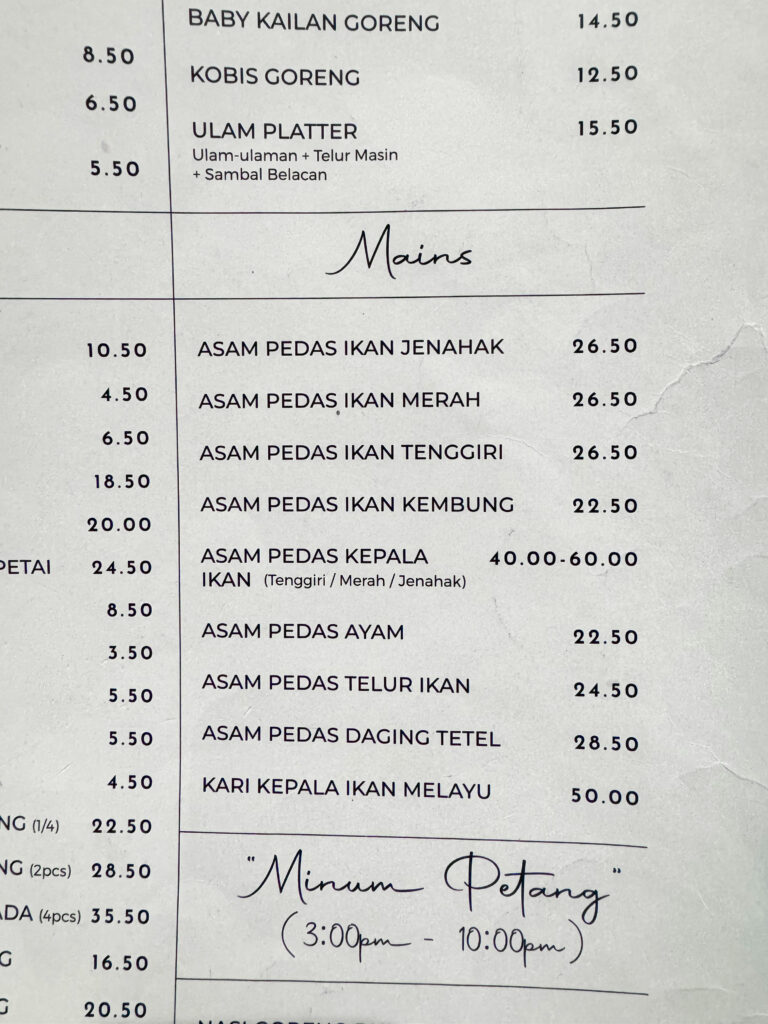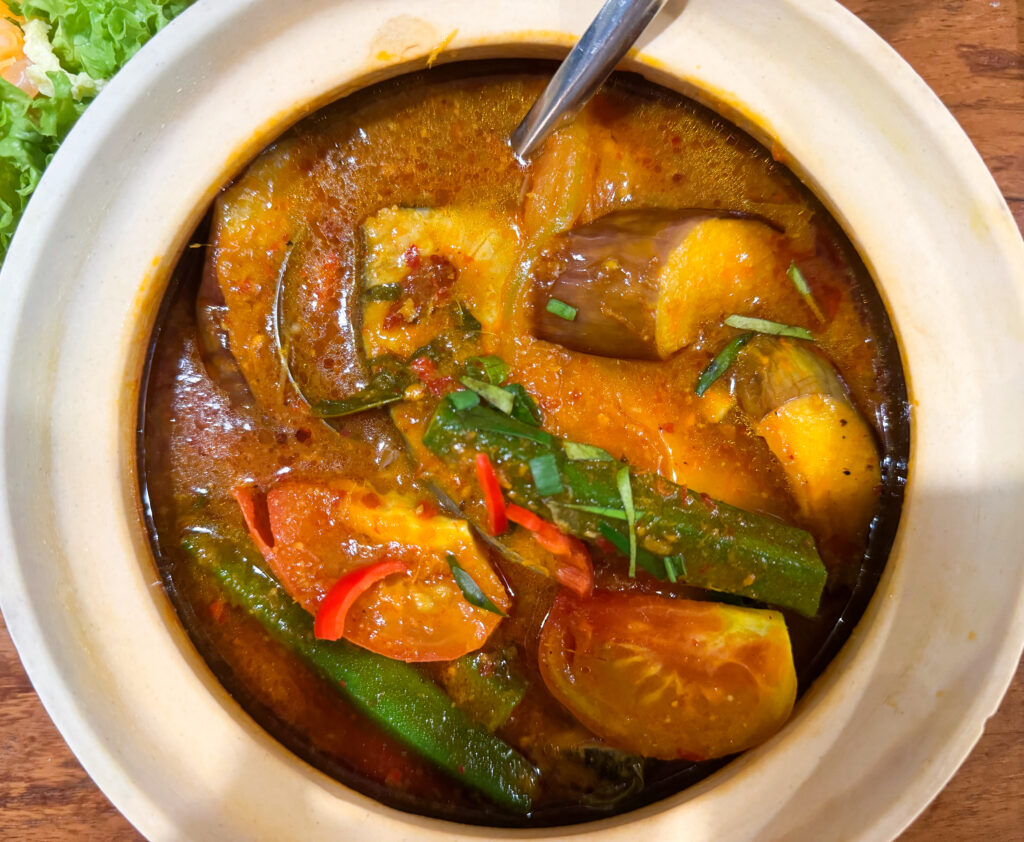We love Asam Pedas. No, you don’t get it, we love Asam Pedas.
It’s not exactly a unique, quirky character trait, since we share the same sentiment with about 34 million other people in Malaysia. If you know a Malaysian or someone who grew up in Indonesia or Singapore, chances are they grew up eating some variation of this dish. And yes– some variation; we’ll explain this in a little bit.
The origin of Asam Pedas is said to be from the Malay communities in the Malay Archipelago, (which includes parts of Malaysia and Singapore) and the Minangkabau cuisine from the island of Sumatra in Indonesia – culinary cultures that traditionally use souring agents like asam jawa (tamarind).
“Whoever wins, writes history. Other than Nyonya food, we don’t have much that is original. Our language and food is borrowed from Indonesia. Technically, even the hot and sour Sichuan soup from China is considered asam pedas.”
Chef Bokhari Khan
During an interview with Chef Bokhari Khan, a Malaysian chef and lecturer in culinary arts from YTL International College of Hotel Management, chimes in with where he thinks Asam Pedas came from. Asam Pedas, when directly translated from the Malay language, means “sour spicy”. There is no better way to summarise the two main flavours in this. The sour part of the dish comes from the most important ingredient, which is asam jawa juice, while the spicy part comes from the blended dried red chillies and ginger. Once that’s done, belacan (fermented shrimp paste), onion, garlic, and turmeric powder is added. That is the start of every Asam Pedas dish.

Aromatics for an Asam Pedas dish is derived from spices like ginger, bunga kantan (torch ginger), daun kesum (Vietnamese coriander) and lemongrass.
Asam Pedas is more than a dish, it is a base that you add your main protein to. Traditionally, for the Malaccan/Melaka Asam Pedas, the protein of choice is usually fish, specifically the ikan tenggiri (Spanish Mackerel) or ikan pari (stingray). Chef Bokhari states, that the sourness from the tamarind juice covers the fishiness, making it ideal for any ocean-dwelling protein dish.

So, here is a look at the four types of Asam Pedas variations found in West Malaysia and Singapore. The list is non-exhaustive, nor is it sequential, and for our tasting, we looked at the differences in ingredients, consistency, and flavour.
Malacca/Melaka Asam Pedas

Say “Asam Pedas” and for most people, the bowl that comes to mind is the Melaka Asam Pedas. The ingredients and aromatics differ, making this Asam Pedas stand out from the rest with the addition of fenugreek seeds, cumin seeds, candlenut, galangal, and a generous amount of kaffir lime leaves, replacing that of the Vietnamese coriander. It also leaves out the torch ginger, taking out the mint and lemongrass-like aroma. Malaccan’s prefer a soupier and thinner consistency. Ideally, the sourness and spice level should be balanced accordingly for the most accurate Melaka Asam Pedas flavour.
I had the joy of trying this variation at The Asam Pedas Place in Kuala Lumpur, a whole restaurant dedicated to the Asam Pedas Melaka! Their Asam Pedas Jenahak or Snapper Asam Pedas was indeed soupy, with chunks of the blended aromatics and spices. The flavours would linger on the tongue longer. It was a good sour-to-spice ratio and the tamarind was less evident, while the shrimp paste took charge.


Nyonya Asam Pedas
The word “Nyonya” is derived from the Indonesian or Malay language, an honorific to describe a foreign married woman, while the men are referred to as “Baba”. The Baba Nyonya or Peranakan Chinese are an ethnic group in Southeast Asia, primarily coming from the Malay Peninsula, that descended from the first wave of Southern Chinese settlers in the region. Peranakan or Nyonya cuisine is thus influenced by Malay, Indonesian, South Indian and Chinese cuisines, somehow effortlessly blending into each other, making up the iconic ‘Nyonya’ taste.
The Nyonya Asam Pedas is distinctly different from the rest of its siblings for a reason, the main difference is the use of lemongrass for the aromatics, and a generous use of fermented dried shrimp paste. Uniquely, both fresh red chillies and dried chillies are added to the blend to form this Asam Pedas base.
The consistency differs depending on the aim of the dish; is the fish the main star, or the gravy? If the idea is to serve a whole fish as a main course, then the Asam Pedas is chunkier. If the Asam Pedas is to be eaten alongside rice and other dishes, then it is soupy and thin, and when the gravy is tasted on its own, you are hit in the face with the tamarind. The flavour is described as ‘sweeter’ than the rest, while maintaining the sour and spice of traditional Asam Pedas.

I went to Big Baba in Taman Desa, Kuala Lumpur, to try their signature Baba’s Asam Pedas, made with the Spanish Mackerel. The soup was indeed thinner and when tasted, the tamarind and sourness stood out immediately! Despite the generous amount of chillies used, the spice does not linger and dissipates quite fast, and the sourness replaces it after.

Northern and Southern Johor Asam Pedas
The unique part of the Johor Asam Pedas is that it has two variations, and they are both different depending on which region you try it in; the north or the south of Johor. Chefs from the south of Johor tend to make their Asam Pedas thicker, with a more curry-like consistency. The southern Johor Asam Pedas also introduces two new ingredients; black pepper and pickled mustard leaves for a spicier and sharper sour flavour. For the northern parts of Johor, spanning from Kluang to Muar, their Asam Pedas is made without black pepper and pickled mustard leaves, and a thinner consistency is preferred.
For vegans or those with dietary restrictions, Asam Pedas can still be enjoyed. The ends of a banana fruit cluster, or the banana blossom, is a great substitute for fish. While some protein substitutes like mung bean-based meat replacements can be used, Chef Bokhari discourages it in an Asam Pedas dish as there is a chance of it disintegrating during the cooking process.
Additionally, for those who wish to substitute the fermented shrimp paste without sacrificing the umami, can try combining miso paste and plant-based fish sauce. Chef Bokhari suggested using blended dried wakame as well.
“Nothing can truly substitute the pungent aroma and flavour of fermented shrimp paste. However, blending dried wakame to a powder and adding it can provide a similar umami and pungent flavour.”
Chef Bokhari Khan

Again, it can’t be understated just how popular this dish is, and yet, there is hardly any documentation of it, nor is there a consensus on ‘what’ it is and how many variants there are of it.
That’s alright. This is not a bad thing, it’s actually a good thing! Because when we say variation, what we really mean is that every single dish categorised under the umbrella of ‘Asam Pedas’ is just an alteration of each other, minute small changes in the ingredients or methods of preparing it, so now you get to pick according to your own preference. This is to say that, at the end of the day, Asam Pedas can be made and enjoyed in a multitude of ways, whether it be with rice or Indian flatbread. As Chef Bokhari states, “there is no true authentic Asam Pedas, to try different authentic variations, don’t walk into a restaurant in different states; go to someone’s house, knock on their door, and ask them to try their Asam Pedas,”. We of course, had to ask him what his favourite variation of Asam Pedas was, he said, and we quote: “-the one my mom makes; back in Negeri Sembilan.”.














